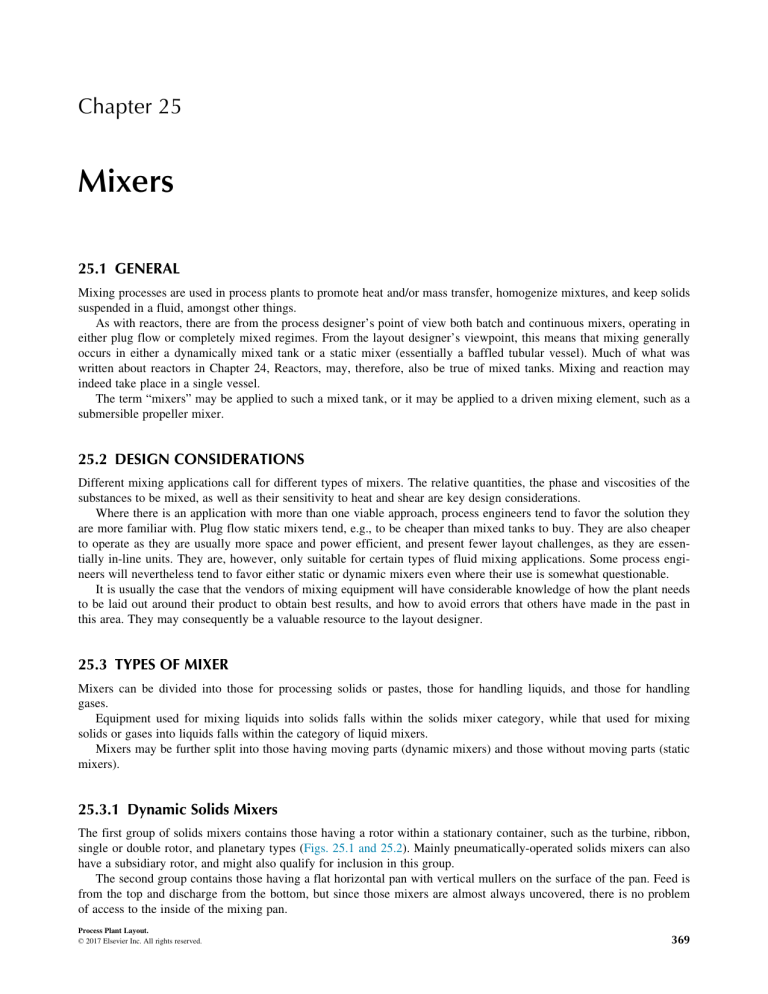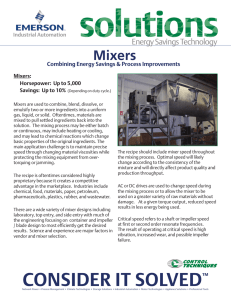
Chapter 25 Mixers 25.1 GENERAL Mixing processes are used in process plants to promote heat and/or mass transfer, homogenize mixtures, and keep solids suspended in a fluid, amongst other things. As with reactors, there are from the process designer’s point of view both batch and continuous mixers, operating in either plug flow or completely mixed regimes. From the layout designer’s viewpoint, this means that mixing generally occurs in either a dynamically mixed tank or a static mixer (essentially a baffled tubular vessel). Much of what was written about reactors in Chapter 24, Reactors, may, therefore, also be true of mixed tanks. Mixing and reaction may indeed take place in a single vessel. The term “mixers” may be applied to such a mixed tank, or it may be applied to a driven mixing element, such as a submersible propeller mixer. 25.2 DESIGN CONSIDERATIONS Different mixing applications call for different types of mixers. The relative quantities, the phase and viscosities of the substances to be mixed, as well as their sensitivity to heat and shear are key design considerations. Where there is an application with more than one viable approach, process engineers tend to favor the solution they are more familiar with. Plug flow static mixers tend, e.g., to be cheaper than mixed tanks to buy. They are also cheaper to operate as they are usually more space and power efficient, and present fewer layout challenges, as they are essentially in-line units. They are, however, only suitable for certain types of fluid mixing applications. Some process engineers will nevertheless tend to favor either static or dynamic mixers even where their use is somewhat questionable. It is usually the case that the vendors of mixing equipment will have considerable knowledge of how the plant needs to be laid out around their product to obtain best results, and how to avoid errors that others have made in the past in this area. They may consequently be a valuable resource to the layout designer. 25.3 TYPES OF MIXER Mixers can be divided into those for processing solids or pastes, those for handling liquids, and those for handling gases. Equipment used for mixing liquids into solids falls within the solids mixer category, while that used for mixing solids or gases into liquids falls within the category of liquid mixers. Mixers may be further split into those having moving parts (dynamic mixers) and those without moving parts (static mixers). 25.3.1 Dynamic Solids Mixers The first group of solids mixers contains those having a rotor within a stationary container, such as the turbine, ribbon, single or double rotor, and planetary types (Figs. 25.1 and 25.2). Mainly pneumatically-operated solids mixers can also have a subsidiary rotor, and might also qualify for inclusion in this group. The second group contains those having a flat horizontal pan with vertical mullers on the surface of the pan. Feed is from the top and discharge from the bottom, but since those mixers are almost always uncovered, there is no problem of access to the inside of the mixing pan. Process Plant Layout. © 2017 Elsevier Inc. All rights reserved. 369 370 PART | III Detailed Layout of Equipment FIGURE 25.1 Dynamic mixer. FIGURE 25.2 Industrial planetary mixer.1 Courtesy: Cjp24. 1. Licensed under CC BY-SA 3.0; https://creativecommons.org/licenses/by-sa/3.0/deed.en Mixers Chapter | 25 371 The third group of solids mixers comprises those with conically shaped rotating tumblers. Feed is through covered holes in the top of the stationary drum. Access platforms need to be provided for large mixers of this type. A fourth group, paste mixers, can be of vertical, horizontal, or angular types. They have heavy power requirements and tend to heat the product in mixing it, so they may require a cooling system. Some have hinged agitators for drum removal and agitator cleaning. Kneader- and Banbury-type paste mixers are heavily built horizontal machines of this type. They can be fed by hand or by conveyor and, for the former, local storage is needed. If they tip for emptying, their range of travel should not be fouled by pipeways nor should it extend into gangways. 25.3.2 Static Solids Mixers Static mixers (Fig. 25.3) have become standard equipment in the process industries. Their application in continuous fluid processing is an attractive alternative to conventional agitation since a better performance can often be achieved at lower cost. Moreover, they typically have lower energy consumption and reduced maintenance requirements because there are no moving parts in this type of mixer. Solids may also be mixed by repeated division and recombination in static mixers, as long as they are free-flowing. Static solids mixers are normally vertically aligned, so that solids flow occurs downward under gravity. 25.3.3 Dynamic Liquid Mixers Liquid mixing tanks have vertical, angular, and sometimes horizontal agitators. The most common type consists of a vertical tank and a top-mounted vertical impeller unit. Mixer-type (stirred tank) reactors have already been described in Chapter 24, Reactors. There are also stand-alone mixers which use rotating propellers and/or a stream of gas to agitate large tanks, whether simply to induce a current or to homogenize the contents. These are commonly found in effluent treatment applications and any rotating propellers are driven either by a fully submersible electrical motor, or by a drive mounted above or beside the tank. Another type of equipment which might fall into this category is a pump used to recirculate liquid within a vessel in order to agitate its contents. Such a pump will normally draw from the bottom of a tank, and deliver to the top. 25.3.4 Static Liquid Mixers Static mixers are baffled tubes or channels which mix fluids with no moving parts. They can be used to mix a number of miscible or immiscible liquid phases, as well as mixing liquids with gases soluble in the liquid. From a layout point of view, they tend to have the same cross-sectional shape and size as the pipe or channel in which they are fitted. FIGURE 25.3 Static mixer. 372 PART | III Detailed Layout of Equipment FIGURE 25.4 Mixer settler stages of action.2 Adapted from Perdula. 25.3.5 Mixer-Settlers Mixer-settlers are used for solvent extraction of metals such as copper and uranium. Each stage consists of a mixed chamber where two phases of liquid are intimately mixed, and a subsequent settling tank where the phases separate out again under gravity. There will usually be multiple countercurrent stages in a commercial plant, as illustrated in Fig. 25.4. 25.3.6 Gas Liquid Mixers Gases and liquids may be mixed by sparging fine bubbles into a tank of liquid (Fig. 25.5), as is commonplace in biological processes in biopharmaceuticals and effluent treatment. Alternatively, liquids may be sprayed into gas-containing vessels, (sometimes known as saturators) or liquids passed over a packed bed, as is the case in in a gas scrubber. They may also be mixed using specialist types of powered or static mixers. Gas liquid mixing usually involves mass transfer of gases into and out of the liquid phase. 25.4 SPACING Gravity flow mixer-settler arrangements have sloped launders or pipes connecting each stage, and it is necessary to provide sufficient head for gravity flow. The “box” arrangement of mixer-settlers—of horizontal rectangular boxes with mixers in alternate compartments, mixing and pumping at the same time—eliminates the need for differences in elevation. As they tend to be rather long, sufficient space must be provided for erection of such a system. 25.5 ARRANGEMENT For dynamic liquid mixers, groups of mixing tanks can be laid out in a straight line, in pairs, or staggered. The last arrangement is useful for pairs of connected mixer-settlers, since the tanks can be physically close together, and have short connections. Space is needed for the solids retention cyclone above a pneumatic solids mixer. 2. Licensed under CC BY-SA 3.0; http://creativecommons.org/licenses/by-sa/3.0/ Mixers Chapter | 25 373 FIGURE 25.5 Gas liquid mixer: FlexAir fine bubble tube diffuser.3 Courtesy: C. Tharp & Environmental Dynamics Inc. FIGURE 25.6 Submersible mixer at a sewage treatment plant.4 Courtesy: Bogelund. 25.6 SUPPORT Paste mixers are heavy and they should be sited on firm foundations, preferably at ground level. Stand-alone submersible dynamic liquid mixers are usually fitted to a guide rail, allowing their removal for maintenance without draining the tank (Fig. 25.6). Such an arrangement usually requires a local davit socket or fixed davit arm to facilitate removal. 3. Licensed under CC BY-SA 3.0; http://creativecommons.org/licenses/by-sa/3.0/ 4. Licensed under CC BY-SA 3.0; https://creativecommons.org/licenses/by-sa/3.0/deed.en 374 PART | III Detailed Layout of Equipment 25.7 MAINTENANCE In all types of dynamic solids mixers, space must be allowed for opening the equipment in order to clean the agitator and casing, and to remove the agitator completely for maintenance. Paste mixers require space and lifting arrangements for removing their heavy internals for maintenance. For flat pan type dynamic solids mixers, a lifting beam or hoist should be provided to enable the whole muller turret to be removed for maintenance. As there is no cover, there must be adequate safety guardrails to protect operators. Conical tumbler dynamic solids mixers have no internals to be maintained so, apart from occasional cleaning of the inside, there is no requirement for maintenance access. Fixed guards must, however, be fitted to keep the operators away from the tumblers while in motion. Dynamic liquid mixing tanks fitted with powered agitators require access to manholes and the agitator drive mechanism on large tanks, as well as the space to remove the whole agitator system. Such space can be saved by using a split shaft with a coupling connection. However, couplings are a source of dynamic imbalance, unless they are properly designed and installed. Maintenance and access is otherwise as described above. 25.8 PIPING In dynamic solids mixers, materials are fed in at the top of the mixer or at one end and the product is removed either from the middle or the opposite end at the bottom of the mixer. The conveyor feeding the materials can be laid out above the mixer from any plan view angle with a chute discharge placed at the correct slope to allow free flow of material. The layout of the discharge side is made in a similar fashion. Mixers with heating or cooling such as the “Banbury” type require associated piping connections, valves, and instrumentation. 25.9 INSTRUMENTATION Care must be taken in locating the instrumentation associated with an in-line static fluid mixer, as the mixing continues after the outlet of the mixer. For example, when dosing acid or alkali for pH control, the pH probe should be placed 10 pipe diameters downstream of the mixer outlet. Similar care must be taken to ensure that instrumentation in dynamic mixers is placed so as to be exposed to a representative sample of the tank contents. 25.10 CASE STUDIES A feature shared by the following case studies is the lack of attention to safety considerations when designing mixing operations, even where the substance being mixed is trinitrotoluene (TNT). People died in two of these case studies, and the other was potentially fatal. Process hazard analysis considering all stages of plant life, including maintenance, start-up, and shutdown is essential. 25.10.1 Unsafe Access to Lime Tank Mixer, United Kingdom, 2015 This is an example of failure to consider safe access for maintenance of mixing equipment and, worse still, allowing something which looked like it might be safe access to remain in place, tempting unwary maintenance crews. A 5 m high domed GRP tank used to store a fine suspension of lime for water treatment was fitted with a top entry mixer. No permanent facilities were installed for hoisting out the mixer, nor any space for temporary facilities. Neither was any provision made for accessing the point where the mixer entered the vessel, its motor, or emergency stop point, despite access to these being required for maintenance operations. There was, however, electrical traywork linking the nearest access to these points which would have tempted operators to use it for access, despite it not being safe for such use, especially on top of a domed tank at height. Source: Personal Communication 25.10.2 Sierra Chemical Co. High Explosives Accident, Mustang, Nevada, United States, January 7, 1998 This is a deadly example of what can happen after a shutdown, included to prompt designers to consider this condition in process hazard analysis and design. It also illustrates the importance of maintaining proper segregation distances, and other explosion-proofing measures. Mixers Chapter | 25 375 On January 7, 1998, two massive explosions just seconds apart destroyed the Sierra Chemical Company’s Kean Canyon explosives manufacturing plant 10 miles east of Reno, Nevada, killing four workers and injuring six others. The initial explosion occurred in a room where workers made “boosters,” small explosive devices used in the mining industry to detonate larger explosives. A second, more powerful blast destroyed a building used for drying pentaerythritol tetranitrate (PETN) explosives, leaving a 12 3 18 m, 1.8 m deep crater. The room where the initial blast occurred had housed four large freestanding mixing pots, where explosive materials were melted and blended. The day before the accident, a worker had departed early, leaving 20 50 kg of melted base material (consisting of TNT and other high explosives) in the bottom of one of the mixing pots. The worker apparently believed that another operator would use the leftover base material later that afternoon. Instead the material remained in the pot and solidified overnight as outside temperatures fell below freezing. The next morning, the worker returned to Booster Room 2. He probably assumed that the pot had been emptied, and without checking its contents, he turned on the motor to the agitator blades, setting off the initial explosion. The two explosions destroyed buildings, blew down walls, and hurled debris as far as a thousand yards. Of the 11 employees who were at the site when the accident occurred, only one escaped without injury. The explosions killed all four workers who were in or near Booster Room 2, where the first blast occurred. In nearby Booster Room 1, one worker was blown over 4 m by the force of that initial blast. He and four others were trapped as the room collapsed, but all survived. The US Chemical Safety Board (CSB) noted that explosives producers should ensure that there are safe distances between buildings to prevent an accidental explosion from propagating. The structures at Sierra Chemical were built on separate terraces cut into the slope of a bowl-shaped desert canyon, but they were located too close to each other. Although the terraced design afforded some protection from horizontal ballistic fragments, the buildings remained vulnerable to falling debris. Based on guidelines from the Institute of Makers of Explosives, the two booster rooms should have been located at least 150 m apart, but the actual distance between them was just 25 m. US Department of Defense guidelines, cited by the CSB, recommend that explosive operations be separated from extraneous work activities by at least 380 m. But at Sierra the production buildings had multiple uses, including unrelated mixing, packaging, and administrative operations. In fact, one of the workers killed was involved in non-explosive-related activities outside Booster Room 2. Building construction was also deficient. For example, the PETN drying building should not have had a skylight, which could be penetrated by explosion debris, and the production buildings should not have been constructed from concrete blocks, which can fragment in an explosion to form potentially lethal projectiles. Source: US Chemical Safety Board (CSB)5 25.10.3 Mixing and Heating a Flammable Liquid in an Open Top Tank, Universal Form Clamp, Inc., Bellwood, Illinois, United States, June 14, 2006 This case study shows what happens if the usual formal engineering design process is set aside in favor of what appeared to be informal upscaling of laboratory bench equipment. Codes are not followed, hazards are not assessed, and “accidents” happen. Universal Form Clamp, Inc. had converted a small portion of its plant into a chemical mixing area, where it produced chemicals used to treat concrete for certain purposes. The area had a 2200 gallon open top tank with steam coils to heat mixtures of chemicals. On the day of the accident, the tank contained over 2700 kg of heptane and 1300 kg of mineral spirits. The tank had a temperature controller, consisting of a liquid-filled temperature sensing bulb and pneumatic control unit. Investigation after the accident found that it had probably malfunctioned due to not being installed or maintained in accordance with manufacturer specifications. The only additional safeguard against overheating the mixture was that, at some point during the mixing operation, an operator was supposed to climb to the top level of the tank and hand-check the temperature of the mixture. There were no alarms and no temperature displays that would indicate a rising temperature. Contrary to existing building and fire codes (NFPA 30), exhaust fans for that area of the facility were at ceiling level; there were no floorlevel exhaust registers to remove vapors that accumulated near the floor. The local exhaust system on the mixing tank itself was broken and not working at the time of the accident. Design and construction of the chemical mixing area had 5. US CSB Investigation Digest (2004) Sierra Chemical Co. High Explosives Accident [online] (accessed 6 June 2016) available at http://www.csb. gov/assets/1/19/CSB_Sierra.pdf 376 PART | III Detailed Layout of Equipment taken place under the direction of a chemist and contract construction engineers. Apparently, neither they nor the local government which approved the construction permit recognized the hazard and the discrepancy from fire code requirements. The accident occurred while a mixture was being heated. The temperature controller malfunctioned, causing the steam valve to remain open and the mixture to heat to the boiling point. The boiling mixture produced a heavy, flammable vapor, which spread to the adjacent areas where it was ignited by one of several possible ignition sources. Workers in the immediate vicinity of the tank saw the vapor cloud and were able to evacuate the facility. However, a deliveryman who happened to be coming into the facility when it was rocked by a large explosion was killed. Source: US Chemical Safety Board (CSB)6 FURTHER READING Kern, R. (1977). Arrangements of process and storage vessels. Chemical Engineering, 84, 93. 6. US CSB (2007) Universal Form Clamp Co. Explosion and Fire [online] (accessed 6 June 2016) available at http://www.csb.gov/universal-formclamp-co-explosion-and-fire/




